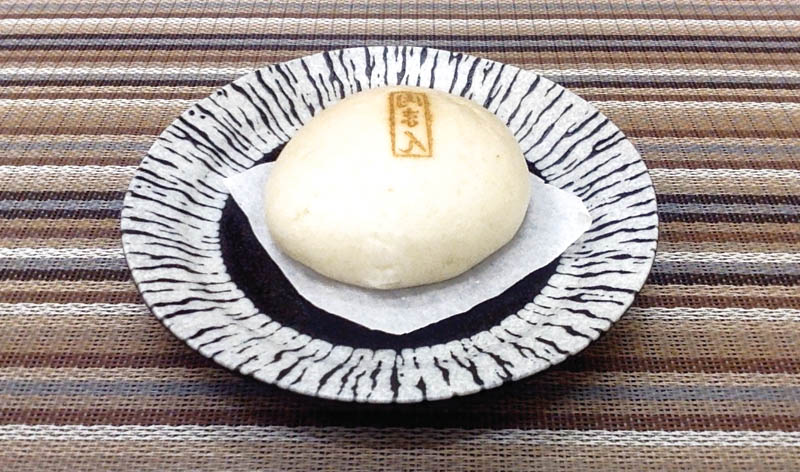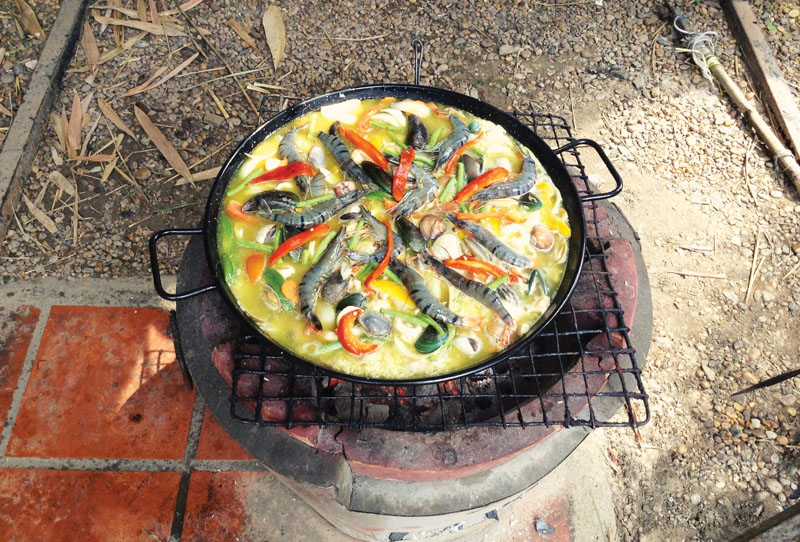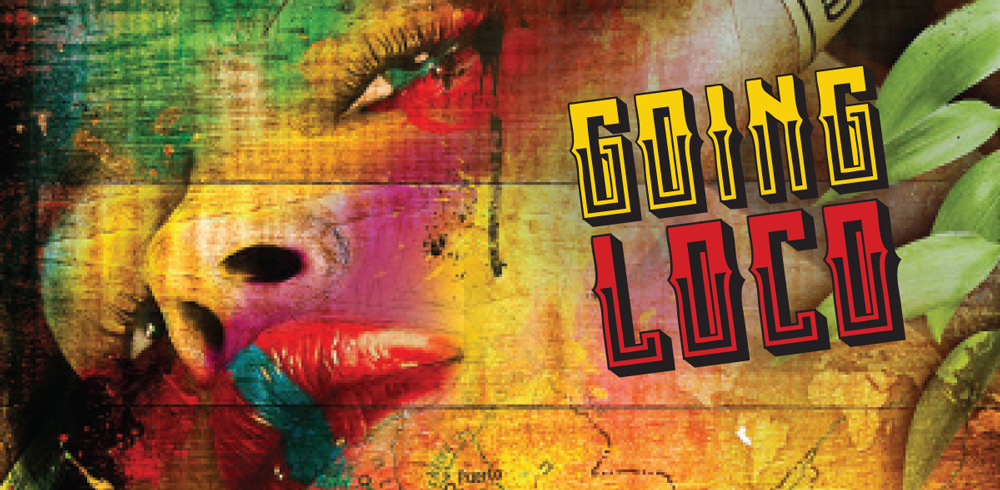Just last week you were idly sipping margaritas on a white-sand beach, and now you are back to the hassle and bustle of the city. As you struggle to readapt to your working schedule after the much-needed holidays, you might find yourself lacking the energy and motivation to drive you through the day, or even daydreaming of the next vacation.
But don’t worry! I have the solution to your woes; the remedy to your incipient pessimism brought about by the end of the good and the return of the routine. The best way to spice up your life, regain your joie de vivre, and, in the process, pump up your confidence: go Latino. Yes, Latino.
You’re about to embark on a one-day journey full of new culinary experiences, colourful drinkable concoctions, impassioned rock ‘n’ roll, and late-night dancing. Here’s my step-by-step guide to living the Latino way in Phnom Penh; a guide to the most seductive part of our beloved city: little Latin America.
Desination #1: Breakfast in Acapulco
Don’t just eat: savour the moment. Latino culture is molded by the drive to enjoy life. The very desire to relish the moment has created a rich and tasteful cuisine in every Latin American country. From meat-heavy Argentina to Mexico’s love for corn, beans and chili peppers, Latin America boasts myriad distinctive cuisines with influences from local ancient civilisations, European colonisers and 20th-century immigrants.
The first stop in our journey takes us to Mexico for breakfast. Alma Café (St. 123 & 454) is a small restaurant near the Russian market, run by a family from Acapulco. If authenticity is what you’re in the mood for, you cannot miss the scrumptious huevos rancheros ($4 with juice and coffee or tea) or the delightful fried chorizo quesadillas ($5). Ingredients brought directly from Mexico, a menu that changes daily (according to the cook’s inspiration), and small/big details like bottomless coffee ($1) are some of the many strong points, along with great food expertly and lovingly brought to you by Mexican chefs. All this explains why the little café has developed a strong following of faithful customers in a matter of months. What sealed the deal for me, however, was the café’s homely feeling, which momentarily transported me to the ‘Land of the Shaking Earth’.
Destination #2: To Bogota for some good old Latin rock
My visit to Alma Café coincides with the restaurant’s celebration of Mexican Independence. Walking along Street 454, I can hear loud Latin rock and the clamour of a large crowd. Inside the restaurant, the party is on: local band Bacano plays a popular Mana hit, while a dozen boozed-up spontaneous dancers bust some salsa moves in between the tables. The place is jam-packed and several would-be diners eagerly wait outside.
Bacano usually has this effect. I’ve seen them perform at Equinox, Latin Quarter and The FCC, always to an excited crowd that fills the place. Covering classic hits from Los Fabulosos Cadillacs, Jarabe de Palo, Carlos Vives, Elefante and other popular Spanish-speaking bands, the sextet’s steamy sound induces everyone to dance to its fusion of rock, salsa and reggae. Bacano may not be the only Latin band in the city, but they are the best established.
I have a chance to talk to Chino, Bacano’s founder and vocalist, about Latino culture in Phnom Penh. The Colombian singer and photographer believes it’s gaining momentum in the capital, as evidenced by the Latino restaurants and bars popping up around the city. Even among locals, Chino believes his culture is gaining popularity. To make his point, he recalls an advertisement tent, somewhere along Sihanouk Boulevard, that had loudspeakers blasting a Khmer version of Camisa Negra by Colombian super-star Juanes. The musician insists the two cultures are not as different as one might think: “The atmosphere in this city is very evocative of home, with its streets full of people and music; these streets, just like in Bogota, are so very alive.”
Destination #3: Lunch in Lima, Bogota and… Madrid
Make lunch tasteful and light by going for tapas at The Latin Quarter, on the corner of streets 178 and 19. Entering this magnificently colourful colonial building, I’m welcomed by fellow Spaniard Florian Lindener López and his Colombian wife, Andrea Posada Nieves. The couple took over the restaurant four months ago, creating a Spanish/Latin American fusion menu shaped by their respective cultures. With impressive educational and professional backgrounds and having worked in Spain’s most renowned culinary venues, including El Bulli and Arzak, they are bringing the best-known Latin American flavours into Phnom Penh’s competitive dining scene. Florian talks with the energy and enthusiasm of someone who loves what they do: “I chose the tapas concept because I have a passion for it,” he declares. “Tapas are fun. As a client, you get to try many dishes. As a cook, you get to explore new ideas.”
The 27-year-old is bent on revolutionising the city’s culinary culture. He recently taught his staff the extravagant and coveted ‘olive spherification’ technique, which he learnt at El Bulli, Ferran Adrià’s now defunct Michelin three-star restaurant. The elaborate process must be carried out with near-surgical precision: it involves extracting the juice of high-quality olives, mixing it with a precise amount of calcium lactate gluconate and xanthan, and carefully submerging spoonfuls of the mix into another mix of sodium alginate and water. After a few minutes, the alginate mix forms a solid screen that encapsulates the olive juice. The resulting green, gel-like pearls hold inside the most intense, concentrated olive-oil flavour ever conjured by human hands.
Florian’s innovations aren’t limited to fancy cooking techniques. He’s also going to great lengths to transmit to his staff all the wisdom he accumulated over the years pertaining to customer service and customer satisfaction. It shows: I’m delighted by the staff’s attention and care; a level of service that is hard to come by in Cambodia.
Although Florian affirms it’s definitely on the rise, Latino/Spanish cuisine has yet to establish itself firmly in the capital. While the concept of tapas is well understood and appreciated among the expat community and tourists, Khmer locals are still a bit flummoxed by this distinctively Spanish approach to food, the young chef confesses.
The Latin Quarter’s menu features items easily recognisable for Latin Americans and Spaniards, such as sea bass ceviche ($5.50), arepas ($4), patatas bravas ($3.50) and paella (small $25, big $45), but with a touch of refinement that will dazzle connoisseurs.
Destination #4: Dinner in Caracas
For dinner, let’s go to a country of overflowing natural riches. Venezuelan-run Tepui, #45 Sisowath Quay, belongs to the restaurant elite of Phnom Penh. It’s located at The Chinese House, a fascinating, one-of-a-kind building that combines Chinese architecture and French colonial styling. With a cocktail bar and art gallery on the first floor, Tepui is the ideal place to spend an evening of sophisticated indulgence.
Head Chef Gisela Salazar Golding masterfully plays with Latin American, Asian and European flavours and ingredients to create innovative and enticing fusion dishes. Traditional Latin American recipes like fajitas, arepas and ceviche are given a new and delicious twist. Ranchero mollet eggs ($6) reach a new level of bliss with the addition of red bean hummus, and the lamb shank ($24) is given a delectable touch of tamarind.
The founder of Tepui, Antonio López de Haros, is a well-known character. Tepui was his first venture in the city, followed by verdant restaurant Botanico GastroBar. “I don’t think ‘the Latino’ is in vogue”, he says over a craft beer. “It’s true that more and more Latino restaurants are appearing around town, but this is not a sign of our culture becoming more popular. What’s happening is that an increasing number of Latin Americans are moving into the city and starting restaurants or bars like the ones they have back home.”
Antonio orders two more locally brewed beers and starts describing in earnest his newest enterprise: the first Cambodian rum.
Destination #5: Stay in Caracas for the rum
Latin Americans know their booze. They invented the mojito, margarita, piña-colada, cuba libre and caipirinha, probably the most famous and widely consumed cocktails in the world. Just for that, they deserve credit for making the world a better place, but they also have some of the best rum in the world, rivalled only by that found in the neighbouring Caribbean.
After dinner, we linger in Venezuela to savour a glass of rum on the rocks. Antonio’s new rum enterprise is called Samai, which in Khmer means ‘modern’, ‘contemporary’ or ‘daydream’: an apt name for something never before produced in this land. The rum is made with Cambodian sugar cane, but following the traditional Venezuelan distillation process: a true child of both cultures.
Antonio and his partners, fellow Venezuelan Daniel Pacheco and Uruguay national Diego Wilkins, are going to great lengths to guarantee an outstanding rum. They’ve imported barrels from Jerez in Spain that were previously used to store Pedro Jiménez and Oloroso wines. In these barrels, Samai will age its premium rum, infusing it with a distinctive sweeter flavour. The first batch of this añejo will be released in 2018 at the earliest, but some will be allowed to age until 2022. Fortunately, you don’t have to wait that long. Now open to the public on Thursday evenings, the Samai Distillery occupies a charming building on Street 830, just off Sothearos Boulevard.
Destination #6: Cocktails around the continent
Our brief rum indulgence can best be complemented with (you guessed it!) more alcohol. We are looking for a place with great ambiance, and for that we return to The Latin Quarter.
Here, the bar offers masterpieces created by Adrian Battle, a top-notch bartender working in Singapore. The mojitos ($4.50) are superb, with just the right amount of rum and sugar to strike that elusive balance of pungent flavour and sweetness. You can also find less mainstream concoctions, such as the creamy and toothsome El Avocado, made with tequila and avocado ($4.50), and the oh-so-aromatic L’bpou Pumpkin Khmer ($4.50), with Red Label and pumpkin puree.
Classy and vintage, without being flashy, this colonial building, reminiscent of Habana, is the perfect place to sip on a mojito and smoke a cigar. As I drink a pisco sour, Florian brings me a couple of spherical olives, also known as ‘liquid olives’. One bite and it’s game over. Florian asks for feedback, but I’ve lost the ability to communicate: the only sensible thing to do is sit back and enjoy the acute flavour that’s just hijacked my senses.
Last stop: Dance in Habana
If indeed “dance is the hidden language of the soul”, as Martha Graham famously said, then few people in the world are as sensuous to the core as Cubans. It’s precisely in hot, exhilarating and sexy Cuba where we put an end to our journey across Phnom Penh’s little Latin America. And we go the best way there is: by dancing.
Although officially born in Los Angeles, salsa’s roots and soul are unmistakably Latin, with the Dominican Republic, Puerto Rico and Cuba the sources of much that inspired it. Much can be said to explain the sensuality that is inherent in salsa dancing, but I think Maite, my guitar teacher in Spain, put it best when she said: “There are two things a guy can do to make a girl fall head over heels: he can play guitar, or he can salsa.”
Think you don’t have what it takes to leave your mark on the dance floor? Think again. Latin dance teacher Olga Lazareva believes anyone can be a good dancer so long as they enjoy it. Together with husband Artemiy Lysykh, she conducts weekly LA-style salsa lessons ($5-$10) at The Groove on Street 282. In her soft yet distinctively Russian manner, she reveals how two Russians found themselves teaching salsa in Phnom Penh: “We were seasoned dancers in Moscow,” she says. “One day Artemiy got an offer from his IT company to relocate to Phnom Penh. We jumped at the opportunity of living in a new country.”
Here for just over a year, the couple has been teaching the ins and outs of Latin dance to expats, tourists and even locals. With backgrounds in discofox, classical dance and Latin dance, and a mastery of the technical elements of each, their lessons are rigorous, fun and entertaining.
It’s 8pm on a Monday and I enter The Groove for my first salsa lesson. I’m impressed: elegant and classy, with a piano in one corner, smartly dressed waiters, and black-and-white pictures of legendary musicians adorning the walls, the venue resembles a speakeasy from the roaring ‘20s. Wearing a brown T-shirt and holey jeans, I feel underdressed and out of place. As the other students arrive, an impressively international line-up assembles: Kazakhstan, Uzbekistan, Japan, Senegal, Gambia, The Philippines, New Zealand, France. There are more than 20 of us, with women making up the vast majority. And they’re dressed to impress, wearing long, shin-grazing dresses. The men sport collared shirts – half-open to expose hairy chests, as is de rigeur on such occasions – and suit pants or jeans (devoid of holes, unlike mine).
The class begins with Olga leading us in a tough stretching session. Her hips and shoulders, moving in opposite directions, impossibly draw an infinity symbol. In my pathetic attempt to emulate her, I end up resembling a convulsing corpse, or perhaps a purging cat. The Russian couple then engages in a long, visually striking and seemingly impossible pattern. After a few seconds of watching them spin and turn amid elaborate arm movements, it dawns on me that this is what we are actually going to learn today.
I grab the warm hands of my first dance partner, a French girl who has a full five centimetres on me. After a few minutes, I feel like the roles have been reversed: she’s definitely leading me. In my struggle to take back the lead and assert my masculinity (yes, ladies: it is belittling for a man to be led), I forget to lower my arm in a turn and accidentally elbow her on the cheek. The women rotate and I get my next partner: a petite Japanese girl. But I can see that I‘m already building a reputation for myself: she is visibly afraid and considering whether to hold my hands or skip me altogether to avoid an elbow to the eye.
By the end of the class, everyone has got the hang of what, in the beginning, seemed impossible. I’m also better at asserting my role as ‘leader’. For the final burst of the night, I’m paired with the tall French girl again. I hold her hands firmly and lead her with determination and a measure of what I like to think passes for grace. All eye sockets remain un-elbowed.
It’s at this point the place transforms into a full-on Latino fest, where couples gracefully pull elaborate strings of moves under the jealous gaze of those left in the bench. Sensuality reaches its apex when the DJ switches to bachata and the men move dangerously close to the women, gently nudging their crotches in time with the suggestive beat. The party rages until well past 1am – not bad for a Monday – and I grab a beautiful girl I’ve been eyening the whole night, attempting to seduce her by engaging in this ancient courtship ritual. I am no Cuban, but the moves I’ve learnt tonight from Olga and Artemiy might just do the trick…


